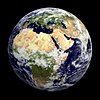TOI-715 bとは、スペクトル分類がM型の恒星であるTOI-715のハビタブルゾーン内を公転しているスーパーアースの太陽系外惑星である[3][4][5]。
主星のTOI-715は、地球からとびうお座[注 1]の方向に約42パーセク(140光年)離れた場所に存在しており、天の南極に非常に近い位置にある赤色矮星である[1]。この恒星は太陽より小さく、温度も低く、見かけの等級は16.7で肉眼で観測することは不可能であり、小型の望遠鏡でも観測が難しいほど暗い恒星である[7]。
TOI-715 bは地球の1.55倍の大きさを持ち、主星から0.083天文単位 (12,400,000 km) 離れている[1]。また、主星のハビタブルゾーン内を公転しており、平衡温度は234 K (−39 °C) である[1]。TOI-715 bは2023年にTESSによって発見され[8]、発見論文の著者によると、保守的なハビタブルゾーンで発見された最初のTESSによって発見された惑星である[1]。「保守的なハビタブルゾーン」の概念は、惑星が地球が太陽から受ける日射量の0.42~0.842倍に相当する日射量を受ける領域であるとして、2014年にKoparappuらによって定義された[9]。TOI-715 bの日射量は0.67+0.15
−0.20 S🜨であるため、保守的なハビタブルゾーン内に位置している[1]。
NASAは、将来的にはジェイムズ・ウェッブ宇宙望遠鏡(JWST)が水や大気の証拠を調査するためにTOI-715 bが観測される可能性があると述べた[10]。さらに、同じ惑星系に2番目の太陽系外惑星TIC 271971130.02が存在する可能性があり、この惑星候補もハビタブルゾーン内を公転しているとされている[10]。
大きさの比較
| 地球
|
TOI-715 b
|

|

|
脚注
注釈
- ^ a b このウェブサイトで赤経 07h 35m 24.26s・赤緯−73° 34′ 38.83″[6]から導出。
- ^ a b パーセクは1 ÷ 年周視差(秒)より計算、光年は1÷年周視差(秒)×3.2615638より計算
出典
- ^ a b c d e f g h i j k l m n o Dransfield, Georgina et al. (2023-10-28). “A 1.55 R⊕ habitable-zone planet hosted by TOI-715, an M4 star near the ecliptic South Pole”. Monthly Notices of the Royal Astronomical Society 527 (1): 35–52. arXiv:2305.06206. doi:10.1093/mnras/stad1439. ISSN 0035-8711. "[W]hile several 'habitable zone' planets discovered by TESS have been confirmed (e.g. Gilbert et al. 2020; Vach et al. 2022), none yet have fallen within the conservative habitable zone as described by Kopparapu et al. (2013)—until now."
- ^ a b c d e f “Results for TOI-715”. SIMBAD Astronomical Database. CDS. 2024年7月31日閲覧。
- ^ “TOI-715 b”. Exoplanet catalog. NASA. 2024年2月4日閲覧。
- ^ Ralls, Eric (February 4, 2024). “Super-Earth discovered in the "optimal" habitable zone of its star, TOI-715 b”. Earth.com. 5 February 2024閲覧。
- ^ “NASA discovers 'Super-Earth' 137 light-years away”. The Economic Times. (February 4, 2024). https://economictimes.indiatimes.com/news/science/nasa-discovers-super-earth-137-light-years-away/articleshow/107404790.cms
- ^ Vallenari, A. et al. (2022). “Gaia Data Release 3. Summary of the content and survey properties”. Astronomy & Astrophysics. arXiv:2208.00211. doi:10.1051/0004-6361/202243940 Gaia DR3 record for this source at VizieR.
- ^ “★ TOI 715” (英語). Stellar Catalog. 2024年6月18日閲覧。
- ^ Nazzaro, Miranda (February 5, 2024). “NASA announces 'super-Earth,' exoplanet in 'habitable zone'”. The Hill. https://thehill.com/homenews/space/4450048-nasa-announces-super-earth-exoplanet-in-habitable-zone/
- ^ Gough, Evan (2024年2月2日). “A Super-Earth (and Possible Earth-Sized) Exoplanet Found in the Habitable Zone” (英語). Universe Today. 2024年6月18日閲覧。
- ^ a b Brennan, Pat (January 31, 2024). “Discovery Alert: A 'Super-Earth' in the Habitable Zone”. NASA News and Events. NASA. 6 February 2024閲覧。
参考文献
- Jain, Vrinda (February 5, 2024). “NASA discovers potentially habitable 'super-Earth' 137 Light-Years Away”. ヒンドゥスタン・タイムズ. https://www.hindustantimes.com/trending/nasa-discovers-potentially-habitable-super-earth-137-light-years-away-101707108812253.html
- Sarnoff, Leah (February 5, 2024). “NASA announces new 'super-Earth': Exoplanet orbits in 'habitable zone,' is only 137 light-years away”. ABCニュース. https://abcnews.go.com/US/nasa-super-earth-habitable-zone-exoplanet/story?id=106961506
- Schwenck, Lennart (February 6, 2024). “Auf der Suche nach Leben: Forscher entdecken Super-Erde in bewohnbarer Zone [In search for life, researchers find super-Earth in habitable zone]” (ドイツ語). ミュンヘナー・メルクーア (Munich). https://www.merkur.de/wissen/der-suche-nach-leben-forscher-entdecken-super-erde-bewohnbare-zone-weltall-auf-92808935.html
- Messier, Ashlyn (February 7, 2024). “NASA announces potentially habitable 'super-Earth,' only 137 light-years away”. FOXニュース. https://www.foxnews.com/lifestyle/nasa-announces-potentially-habitable-super-earth-137-light-years-away
関連項目
|
|---|
| 探査機 | | |
|---|
| 天体カタログ | |
|---|
主な恒星および
発見した惑星
(TOI) |
| 2018年 | |
|---|
| 2019年 | |
|---|
| 2020年 | |
|---|
| 2021年 | |
|---|
| 2022年 | |
|---|
| 2023年 | |
|---|
| 2024年 | |
|---|
|
|---|
| 一覧 | |
|---|
関連する
プロジェクト | |
|---|
| その他 | |
|---|
| 公式サイト | |
|---|





